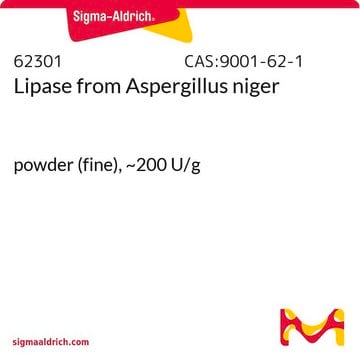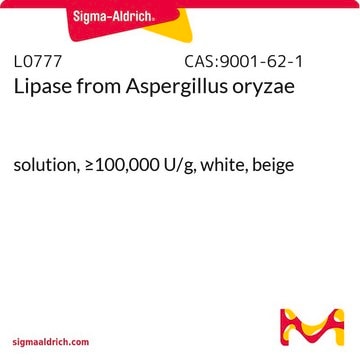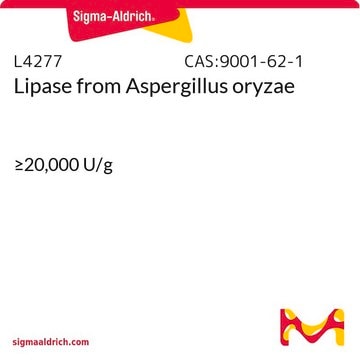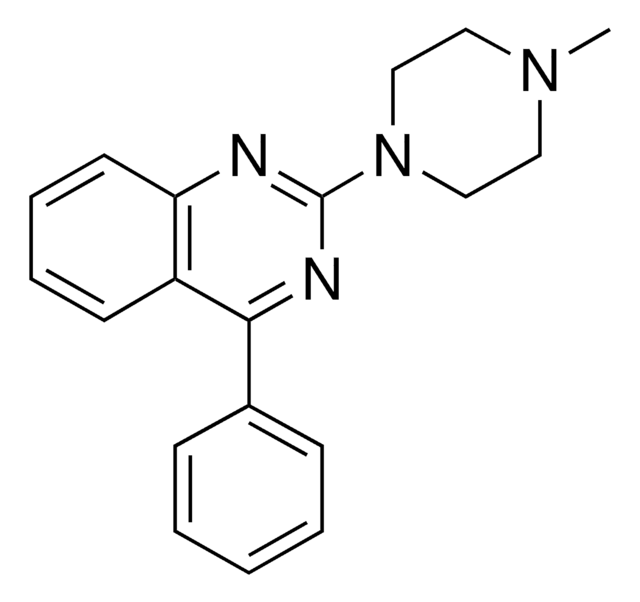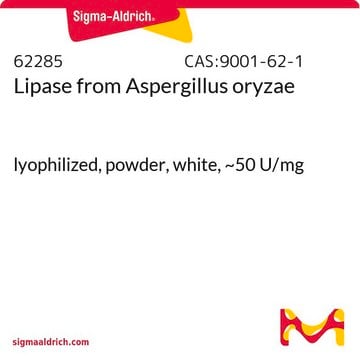Lipases catalyze the hydrolysis of triacylglycerols into glycerol and free fatty acids.
Please refer to Enzyme Commission number: 3.1.1.3 which can be found on the product landing page:
https://www.sigmaaldrich.com/product/sigma/l1754
L1754
Lipase from Candida rugosa
Type VII, ≥700 unit/mg solid
Synonym(s):
Triacylglycerol acylhydrolase, Triacylglycerol lipase
About This Item
Recommended Products
biological source
fungus (candida rugosa)
Quality Level
type
Type VII
form
lyophilized
specific activity
≥700 unit/mg solid
storage condition
(Tightly closed. Dry)
technique(s)
cell based assay: suitable
color
beige
white
solubility
water: slightly soluble
storage temp.
2-8°C
InChI
1S/C11H9N3O2.Na/c15-8-4-5-9(10(16)7-8)13-14-11-3-1-2-6-12-11;/h1-7,16H,(H,12,14);/q;+1/b13-9-;
InChI key
QWZUIMCIEOCSJF-CHHCPSLASA-N
Looking for similar products? Visit Product Comparison Guide
General description
Lipases are found in pancreatic secretions. This class of enzymes contains α and β hydrolase folds.[1] Candida rugosa produces multiple lipase isoenzymes that have 80% sequence homology.[2]
Application
- to synthesize dextran fatty acid esters[3]
- to study the effect of lipase on conjugated linoleic acid (CLA1 and CLA2) production in the presence of sunflower oil and castor oil[4]
- to prepare pH-imprinted enzyme for lipase-catalyzed transesterification of dextran T-40 with vinyl decanoate[5]
Biochem/physiol Actions
Lipases catalyze the hydrolysis of triacylglycerols into glycerol and free fatty acids.
Unit Definition
antibody
enzyme
related product
Signal Word
Danger
Hazard Statements
Precautionary Statements
Hazard Classifications
Resp. Sens. 1
Storage Class Code
11 - Combustible Solids
WGK
WGK 1
Flash Point(F)
Not applicable
Flash Point(C)
Not applicable
Personal Protective Equipment
Choose from one of the most recent versions:
Already Own This Product?
Find documentation for the products that you have recently purchased in the Document Library.
Customers Also Viewed
-
Why is the definition of Enzymatic activity "One Unit will Hydrolyze 1 µequivalent of Fatty Acid from TG” instead of “One Unit will liberate 1 µequivalent of Fatty Acid from TG”. In fact, a Fatty acid is not hydrolyzed but liberated from TG hydrolysis.
1 answer-
Helpful?
-
-
which polysaccharide was utilized in the lyophilized form of CRL as stabilizing agent, and how to remove it before working with this formula to avoid the impact of polysaccharides on immobilization process.
1 answer-
This product contains lactose as a carrier. Information on how to remove the lactose has not been determined.
Helpful?
-
-
What is the stability of Product L1754, Lipase from Candida rugosa solutions, and how should they be stored?
1 answer-
Solutions in 50% glycerol may be stored at -20°C up to six months. Avoid repeated freeze/thaw cycles. It is best to store aliquots in working volumes.
Helpful?
-
-
What is the Department of Transportation shipping information for this product?
1 answer-
Transportation information can be found in Section 14 of the product's (M)SDS.To access the shipping information for this material, use the link on the product detail page for the product.
Helpful?
-
-
What is the difference between Candida rugosa and Candida cylindracea?
1 answer-
These organisms are identical strains. C. rugosa was assigned to what was previously named C. cylindracea by the ATCC.
Helpful?
-
-
What is the solubility of Product L1754, Lipase from Candida rugosa?
1 answer-
This product is soluble in water at 1 mg/mL.
Helpful?
-
Active Filters
Our team of scientists has experience in all areas of research including Life Science, Material Science, Chemical Synthesis, Chromatography, Analytical and many others.
Contact Technical Service

